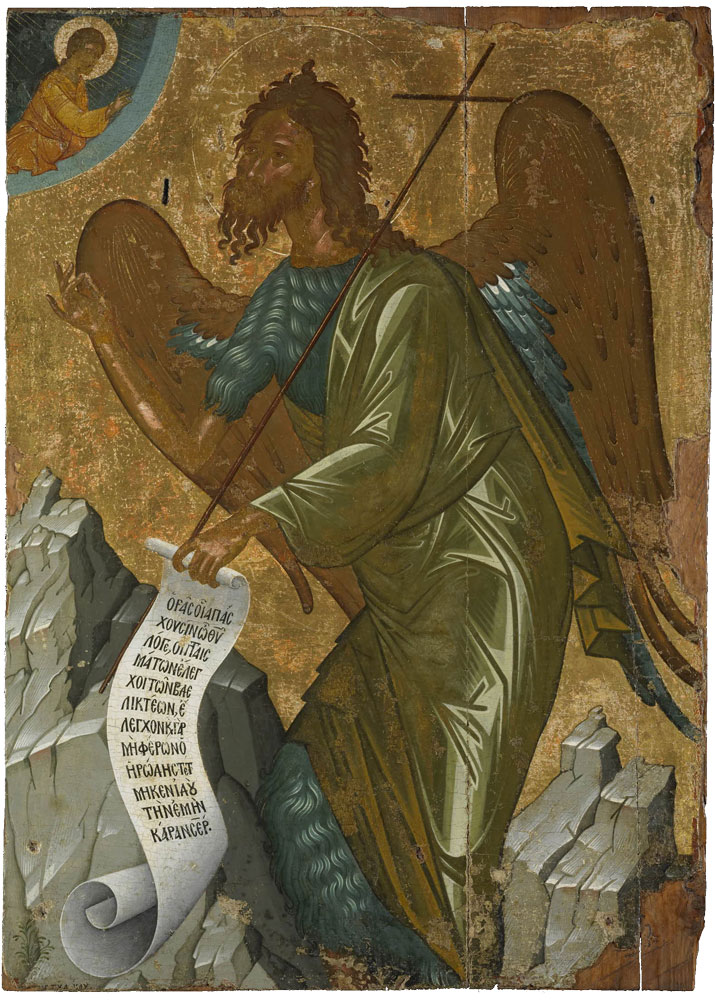
Icon with St John the Baptist
Origin
Crete
Object Date
c. 1450
Metric Dims
89cm; W. 64cm
Inventory Number
Reg. no. BEP 2000,1106.1
Additional Details
(Cormack 97)
Provenance
Bequeathed by Ella Wentworth Dyne Steel in 2000.

Origin
Crete
Object Date
c. 1450
Metric Dims
89cm; W. 64cm
Inventory Number
Reg. no. BEP 2000,1106.1
Additional Details
(Cormack 97)
Provenance
Bequeathed by Ella Wentworth Dyne Steel in 2000.
The icon is painted in egg tempera with gold leaf on cedar wood primed with gesso over linen. It represents the winged figure of St John the Baptist who is standing in front of two rocky grey-coloured mountains and is turned to the left. He is blessing with his right hand and holding an inscribed scroll and a staff ending in a cross with his left. The inscription on the scroll, written in black capital letters, reads: ΟΡΑC ΟΙΑ ΠΑC/ΧΟVCΙΝ ω Θ(ΕΟ)Y ΛΟΓΕ, ΟΙ ΠΤΑΙC/ΜΑTωΝ ΕΛΕΓ/ΧΟΙ ΤωΝ ΒΔΕ/ΛΙΚΤΕωΝ Ε/ΛΕΓΧΟΝ Κ(ΑΙ) ΓΑΡ/ ΜΗ ΦΕΡωΝ Ο / ΗΡωΔΗC ΤΕΤ/ΜΗΚΕΝ ΙΔΟΥ / ΤΗΝ ΕΜΗΝ / ΚΑΡΑΝ C(ωΤ)ΕΡ (‘You see what they suffer, O Word of God, those who condemn the faults of the loathsome; and therefore, Herod, not being able to bear my condemnation, severed my head, Saviour’). From a quadrant on the upper left corner the figure of the blessing Christ appears. The quadrant is rendered with gold striations and has a light blue frame.
The icon is cut down on all sides, but the major part must have been removed from the lower side of the icon. St John must have originally been shown full length; the lower legs are now cut. There must have been a chalice on the ground containing his severed haloed head, which has not survived either. The cutting of the icon also affected a dedicatory inscription on the left bottom of the composition of which only the upper part has been partially preserved. It can be partially completed as: ΔΕΗCΙC ΤΟΥ ΔΟΥΛΟΥ (‘supplication of the servant …’).
The icon has been attributed to the Cretan painter Michael Damaskinos and compared with an icon by this painter in the Museum of Zakynthos, dated to the second half of the 16th century (Lymberopoulou 2003). A further look at the icon, however, reveals a painterly style that brings it closer to the work of the painter Angelos, active in the first half of the 15th century, than to that of Michael Damaskenos. Certain features such as the blessing Christ appearing from a quadrant are identical to those in the icons of St John the Baptist by Angelos, one in the Byzantine Museum in Athens (Acheimastou-Potamianou 1989–90; Acheimastou-Potamianou 1998) and a second in the Hof van Busleyden Museum in Malines, Belgium (Vassilaki 2010).
Literature: M. Acheimastou-Potamianou, ‘Δύο εικόνες του ζωγράφου Αγγέλου και του Ανδρέα Ρίτζου στο Βυζαντινό Μουσείο’, Δελτιον της Χριστιανικής Αρχαιολογικὴς Εταιρείας 15 (1989-90), 105–18; M. Acheimastou-Potamianou, Icons of the Byzantine Museum of Athens, Athens, 1998, no. 28; A. Lymberopoulou, ‘A winged St John the Baptist icon in the British Museum’, Apollo 158, no. 500 (November, 2003), 19–24; R. Cormack, Icons, London, 2007 (repr. 2014), 95, fig. 59, 103, 137, no. 97. M. Vassilaki (ed.), The Hand of Angelos. An Icon Painter in Venetian Crete (exh. cat., The Benaki Museum), Athens, 2010, no. 38.
Maria Vassilaki